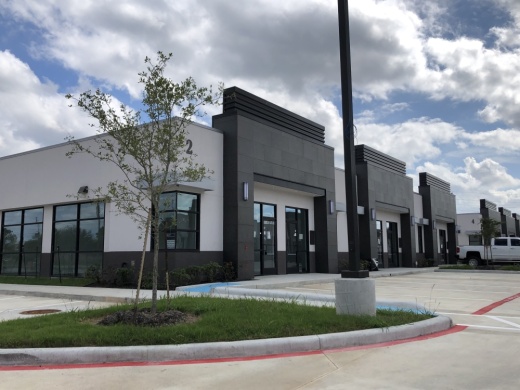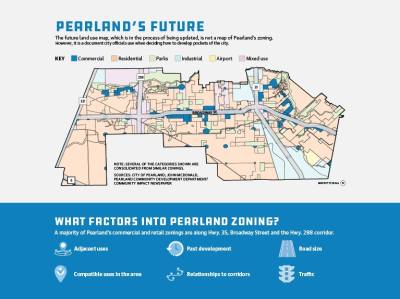Additionally, the city and Pearland Economic Development Corp. continued working on attracting businesses and moving forward with city buildings in 2020 and 2021. The Pearland Community Development Department also began the process of updating its comprehensive plan, which is a detailed document that gives a 20-year outlook of the city’s plans and was last updated in 2015.
One of the city’s biggest goals is to create a diverse economy that boasts retail, restaurant, medical and industrial businesses, according to officials with the Pearland Chamber of Commerce and PEDC.
Coinciding with the city’s economic goals has been Pearland’s growing population, which grew by 37% from 2010 to 2020, according to the U.S. Census Bureau.
Businesses are finding the city attractive with the increase in new residents, Pearland Chamber of Commerce CEO Jim Johnson said.
“I think as the population grows, it means we have the labor market. It means we have the retail consumers,” he said. “Whatever data you’re looking at, ... it checks the boxes needed for those businesses to locate here in Pearland.”
Along with the city’s plans, the PEDC also aims to strengthen Pearland’s economic development.
One thing the PEDC established to reach that goal is the Pearland Prosperity community strategic plan, which began in 2019.
The Pearland Prosperity Plan was established by the PEDC with two goals: grow and diversify the city’s economy and make Pearland a community of choice in the Greater Houston area, according to the PEDC.
“One of our goals of our strategic plan is economic diversification,” PEDC President Matt Buchanan said. “We want to go back in and make sure that we are also diversifying our tax base, which is important to our schools, important to our city and county.”
Population draws
Pearland is the eighth fastest-growing city with a population of at least 100,000 people in the U.S., according to the U.S. Census Bureau.
Pearland’s growing community has attracted all businesses because companies know the city has the population both to serve and be a workforce, Johnson said.
Millar Inc., a company that manufactures medical devices, announced in October it is moving from Houston to Pearland. Having access to hotels, restaurants, entertainment and the Texas Medical Center were all factors that attracted Millar to Pearland, Millar CEO Tim Daugherty said.
“The big piece for us was really the Pearland Economic Development Corp., just their commitment on building the Lower Kirby District into a life sciences hub. That really appealed to us,” Daugherty said.
The PEDC said it supported the move of Millar’s headquarters to Pearland because it goes along with strengthening the city’s economy. Officials compared it to Merit Medical Systems, which, like Millar, also is a medical device manufacturer located on Kirby Drive.
The revenue generated by Merit eventually came back to Pearland, paid local residents and grew the city’s economy, Buchanan said.
According to a community assessment in the PEDC’s Pearland Prosperity plan, from 2013 to 2018, job growth in retail trade grew 20.2% compared to 4.7% nationally, and accommodation and food services grew 26.7% in Pearland compared to 13% in the U.S., Buchanan said.
While the data is from prior to the COVID-19 pandemic, both Johnson and Pearland Community Development Director John McDonald said the biggest result they have seen from the pandemic was that the growth of Pearland businesses stalled out temporarily but began to see an uptick again beginning in fall 2020, which was supported by new building commercial permits issued in Pearland from 2019 to 2021.
Additionally, Pearland sales tax revenue collected in October 2019 and October 2020 was roughly $2.61 million each, according to the Texas comptroller of public accounts. In October this year, Pearland collected $3.15 million in sales tax revenue.
The city’s location and infrastructure has played a role in its success, Johnson said, which is something Daugherty echoed when he described some of the other amenities the city offers.
“They’re all within an area that is highly visible, highly accessible and in a highly concentrated population area, so they can better serve their patients,” Johnson said.
Corridor growth
The PEDC and the city’s community development department anticipate the bulk of Pearland’s economic sectors to continue thriving along its main corridors, which are Hwy. 35, Broadway Street and Hwy. 288.
“It’s about access,” McDonald said. “It’s about transportation. It’s about being able to get to locations, and obviously with those major thoroughfares, providing those routes, those will continue to be our commercial corridors.”
Pearland issued 92 commercial permits for the construction of new buildings from 2019 through Oct. 26 in 2021, according to data provided by the city. Of those 92, 20 came in 2019, 44 in 2020 and 28 in 2021.
Each permit accounts for the construction of anything new from city-owned facilities to individual retail buildings or restaurants, retail strip centers and office buildings.
Of those 92 permits, 64 were either on or in close proximity to Hwy. 35, Broadway Street or Hwy. 288, according to permit data.
While the three thoroughfares remain the primary business sectors for Pearland, there is also a rise along secondary economic corridors. These areas see a lot more convenience-based businesses, which are any businesses that serve the immediate needs of a neighborhood without residents having to travel to a major shopping area, Johnson said.
Of the remaining 28 new building permits that were not along one of the major corridors, eight had an address on or were in close proximity to Shadow Creek Parkway or Pearland Parkway. McDonald said those two thoroughfares could see more secondary development in the future, as the roads have already seen new businesses and developments in recent years.
“There are still a few places on the north on Pearland Parkway that will fill in,” McDonald said.
Additionally, the intersection of Barry Rose Road and Pearland Parkway has begun to get new strip centers and is an intersection that the city could continue to see more development in the coming years, McDonald said.
Future of Pearland’s commerce
Where and how new businesses open in Pearland, however, depends on zoning.
One of the tools the city uses when making development decisions is its future land use map, which is a part of the city’s comprehension plan, McDonald said.
The plan guides the city with future infrastructure, transportation, housing, land use and economic development, McDonald said.
Various factors go into what zoning the city chooses for certain areas, McDonald said.
The city is looking for citizen input to incorporate into an updated comprehension plan that the community development department aims to get to City Council by mid-2022, he added.
Pearland is primarily zoned for commercial and business uses along Broadway Street from Business Center Drive just west of Hwy. 288 all the way along the thoroughfare until it reaches the city’s limits on the east side at the Friendswood border, according to the city of Pearland’s zoning district map.
The area along Hwy. 35 also mostly comprises commercial and business zonings with pockets of residential and industrial zonings farther south. Along the Hwy. 288 corridor, there are pockets of commercial and residential zonings, according to the zoning map.
Across the city’s Lower Kirby District and Mykawa Road there are portions of industrial and mixed-use zonings, according to the zoning map. The city has over 20 categories for zoning districts.
“As we continue to grow, we have more talent, more people, and that gives a better pool for companies to pull from,” Buchanan said. “So, I think you’re going to continue to see announcements from us—like Millar—of companies that are choosing Pearland.”







